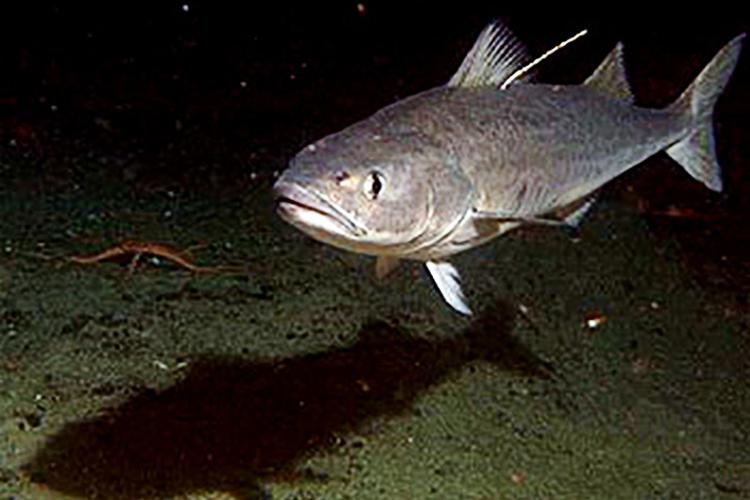Offshore Waters
Almost all Gulf of Alaska, Bering Sea, and Aleutian Islands tags have been released during annual sablefish longline surveys. During the years of the Japan-U.S. Cooperative Longline Survey (1978-94), all tagging was done aboard Japanese vessels by Japanese and U.S. scientists working together. The NMFS annual Domestic Longline Survey began in 1987 and replaced the Cooperative Survey in 1995. Since 1997, tagging in offshore waters has been done aboard chartered commercial vessels during the NMFS annual Domestic Longline Survey.
![Triangles represent longline survey stations where fish are tagged and released.]()
Triangles represent longline survey stations where fish are tagged and released.
Inside Waters
Most of the nearly 65,000 tags released by NOAA Fisheries in Chatham and Clarence Straits in the Alexander Archipelago have been released from various NOAA research vessels, including the NOAA ships John N. Cobb and Townsend Cromwell. The State of Alaska has jurisdiction over fisheries in these waters, and many of the tag releases were made in cooperation with the Alaska Department of Fish and Game.
Juvenile Sablefish
Juvenile sablefish in southeast Alaska make up a third group of NOAA Fisheries tag releases. Beginning in 1985, juvenile sablefish were tagged and released in a number of bays and inlets in southeast Alaska, ranging from Ketchikan to Juneau. Most of these fish were tagged from the NOAA ships John N. Cobb and Murre II or from docks in Sitka, Ketchikan, and Juneau. Nearly 35,000 juvenile sablefish have been tagged and released to date.
![Recoveries of known-age tagged juveniles by recovery size and recovery area, recovered 0 – 2 years following release (top left panel), recovered 3 – 4 years following release (top right panel), recovered 5 – 6 years following release (bottom left panel), and recovered 7+ years following release (bottom right panel). BC = British Columbia, EGOA = Eastern Gulf of Alaska (GOA), CGOA = Central GOA, WGOA = Western GOA, AI = Aleutian Islands, and BS = Bering Sea. Size 1 = 41-56 cm, size 2 = 57-66 cm, and size 3 >66 cm.]()
Recoveries of known-age tagged juveniles by recovery size and recovery area, recovered 0 – 2 years following release (top left panel), recovered 3 – 4 years following release (top right panel), recovered 5 – 6 years following release (bottom left panel), and recovered 7+ years following release (bottom right panel). BC = British Columbia, EGOA = Eastern Gulf of Alaska (GOA), CGOA = Central GOA, WGOA = Western GOA, AI = Aleutian Islands, and BS = Bering Sea. Size 1 = 41-56 cm, size 2 = 57-66 cm, and size 3 >66 cm.
Other Studies
Other recent tagging studies include electronic tagging of adult sablefish, electronic tagging of juvenile sablefish in southeast Alaska, tagging of adult sablefish with pop-off satellite tags, and tagging of sablefish on Gulf of Alaska seamounts.
![An electronic archival tag and a pencil pointing to the location of insertion on a juvenile sablefish.]()
An electronic archival tag and a pencil pointing to the location of insertion on a juvenile sablefish.
Data
![MESA-pop-off_satellite_tag.jpg]()
Picture of a pop-off satellite tag on an adult sablefish.
Tag release and recovery data are stored in the NOAA Fisheries Alaska Sablefish Tag Database. Analysis of tag data is the primary method used to study sablefish movements. The results show that sablefish are highly migratory for at least part of their lives, and their movement rates are great enough to affect the amount of fish available for harvest in an area. Although the results of the longline survey are the main data used to determine sablefish quotas, tag data provide complementary information that has been used to augment the data from the longline survey. Tag data have also been used to validate otolith aging and to help determine the age of recruitment into the fishery.
Migration
Several tagging studies have shown sablefish to be highly migratory for at least part of their life cycle, with the pattern of movement related to fish size. Young sablefish routinely undertake migrations of a thousand miles or more, and older fish commonly travel the same distance on a return journey. In general, these studies show that small fish in the eastern areas of the Gulf of Alaska travel north and westward from their release sites and large fish tagged in the western areas of the Gulf of Alaska move eastward. Large fish tagged in the eastern areas of the Gulf of Alaska have a tendency to remain there. The stages of sablefish migration coincide with the stages of maturity: small fish moving west are young and immature and large fish returning eastward are older and mature. During the migration, younger fish, which have come from shallow inshore waters, move further out on the continental shelf and eventually end up as adults in the deeper waters of the continental slope where spawning takes place.
Tag Rewards
A reward (usually a baseball cap or a T-shirt) is offered for the return of a tag. In addition, each tag is entered in the annual cash prize drawing with prizes ranging from $250 to $1000.
Tags may be yellow, red, or orange and are usually located below the first dorsal fin on the left side of the fish. Please send tags with as much of the following information as possible.
Additional Resources
Contact





